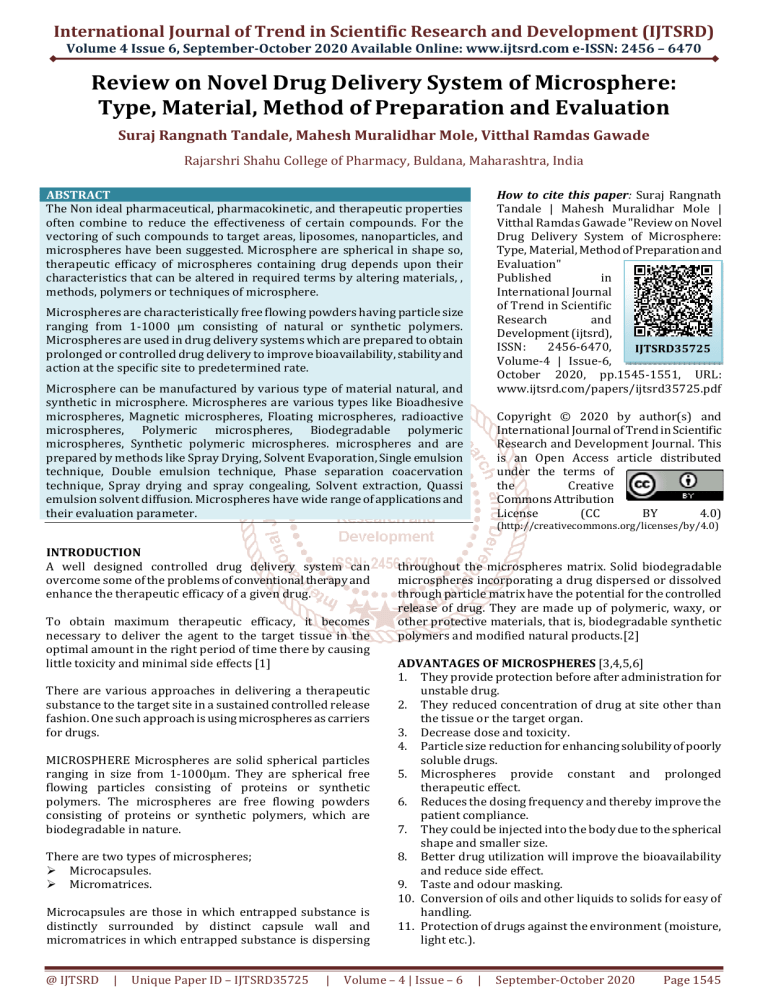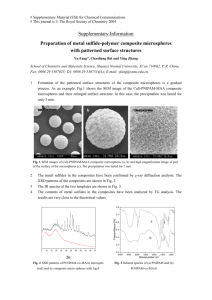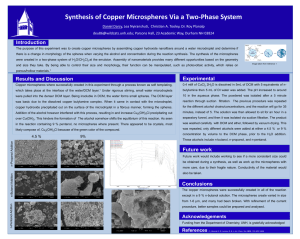
International Journal of Trend in Scientific Research and Development (IJTSRD)
Volume 4 Issue 6, September-October 2020 Available Online: www.ijtsrd.com e-ISSN: 2456 – 6470
Review on Novel Drug Delivery System of Microsphere:
Type, Material, Method of Preparation and Evaluation
Suraj Rangnath Tandale, Mahesh Muralidhar Mole, Vitthal Ramdas Gawade
Rajarshri Shahu College of Pharmacy, Buldana, Maharashtra, India
ABSTRACT
The Non ideal pharmaceutical, pharmacokinetic, and therapeutic properties
often combine to reduce the effectiveness of certain compounds. For the
vectoring of such compounds to target areas, liposomes, nanoparticles, and
microspheres have been suggested. Microsphere are spherical in shape so,
therapeutic efficacy of microspheres containing drug depends upon their
characteristics that can be altered in required terms by altering materials, ,
methods, polymers or techniques of microsphere.
How to cite this paper: Suraj Rangnath
Tandale | Mahesh Muralidhar Mole |
Vitthal Ramdas Gawade "Review on Novel
Drug Delivery System of Microsphere:
Type, Material, Method of Preparation and
Evaluation"
Published
in
International Journal
of Trend in Scientific
Research
and
Development (ijtsrd),
ISSN:
2456-6470,
IJTSRD35725
Volume-4 | Issue-6,
October 2020, pp.1545-1551, URL:
www.ijtsrd.com/papers/ijtsrd35725.pdf
Microspheres are characteristically free flowing powders having particle size
ranging from 1-1000 μm consisting of natural or synthetic polymers.
Microspheres are used in drug delivery systems which are prepared to obtain
prolonged or controlled drug delivery to improve bioavailability, stability and
action at the specific site to predetermined rate.
Microsphere can be manufactured by various type of material natural, and
synthetic in microsphere. Microspheres are various types like Bioadhesive
microspheres, Magnetic microspheres, Floating microspheres, radioactive
microspheres, Polymeric microspheres, Biodegradable polymeric
microspheres, Synthetic polymeric microspheres. microspheres and are
prepared by methods like Spray Drying, Solvent Evaporation, Single emulsion
technique, Double emulsion technique, Phase separation coacervation
technique, Spray drying and spray congealing, Solvent extraction, Quassi
emulsion solvent diffusion. Microspheres have wide range of applications and
their evaluation parameter.
Copyright © 2020 by author(s) and
International Journal of Trend in Scientific
Research and Development Journal. This
is an Open Access article distributed
under the terms of
the
Creative
Commons Attribution
License
(CC
BY
4.0)
(http://creativecommons.org/licenses/by/4.0)
INTRODUCTION
A well designed controlled drug delivery system can
overcome some of the problems of conventional therapy and
enhance the therapeutic efficacy of a given drug.
To obtain maximum therapeutic efficacy, it becomes
necessary to deliver the agent to the target tissue in the
optimal amount in the right period of time there by causing
little toxicity and minimal side effects [1]
There are various approaches in delivering a therapeutic
substance to the target site in a sustained controlled release
fashion. One such approach is using microspheres as carriers
for drugs.
MICROSPHERE Microspheres are solid spherical particles
ranging in size from 1-1000µm. They are spherical free
flowing particles consisting of proteins or synthetic
polymers. The microspheres are free flowing powders
consisting of proteins or synthetic polymers, which are
biodegradable in nature.
There are two types of microspheres;
Microcapsules.
Micromatrices.
Microcapsules are those in which entrapped substance is
distinctly surrounded by distinct capsule wall and
micromatrices in which entrapped substance is dispersing
@ IJTSRD
|
Unique Paper ID – IJTSRD35725
|
throughout the microspheres matrix. Solid biodegradable
microspheres incorporating a drug dispersed or dissolved
through particle matrix have the potential for the controlled
release of drug. They are made up of polymeric, waxy, or
other protective materials, that is, biodegradable synthetic
polymers and modified natural products.[2]
ADVANTAGES OF MICROSPHERES [3,4,5,6]
1. They provide protection before after administration for
unstable drug.
2. They reduced concentration of drug at site other than
the tissue or the target organ.
3. Decrease dose and toxicity.
4. Particle size reduction for enhancing solubility of poorly
soluble drugs.
5. Microspheres provide constant and prolonged
therapeutic effect.
6. Reduces the dosing frequency and thereby improve the
patient compliance.
7. They could be injected into the body due to the spherical
shape and smaller size.
8. Better drug utilization will improve the bioavailability
and reduce side effect.
9. Taste and odour masking.
10. Conversion of oils and other liquids to solids for easy of
handling.
11. Protection of drugs against the environment (moisture,
light etc.).
Volume – 4 | Issue – 6
|
September-October 2020
Page 1545
International Journal of Trend in Scientific Research and Development (IJTSRD) @ www.ijtsrd.com eISSN: 2456-6470
12. Improvement of flow of powders.
13. Aid or helps in the dispersion of water-insoluble
substances in aqueous media.
Disadvantage of microsphere [7]
1. The costs of the materials and processing of the
controlled release preparation, are substantially higher
than those of standard formulations.
2. The fate of polymer matrix and its effect on the
environment.
3. The fate of polymer additives such as plasticizers,
stabilizers, antioxidants and fillers.
4. Reproducibility is less.
5. Process conditions like change in temperature, pH,
solvent addition, and evaporation/agitation may
influence the stability of core particles to be
encapsulated.
6. The environmental impact of the degradation products
of the polymer matrix produced in response to heat,
hydrolysis, oxidation, solar radiation or biological agents
[7].
Materials
Microspheres used usually are polymers. They are classified
into two types:
Synthetic Polymers
Natural polymers
Synthetic polymers are divided into two types.
A. Non-biodegradable polymers
Poly methyl methacrylate (PMMA), Acrolein, Glycidyl
methacrylate, Epoxy polymers
B. Biodegradable polymers
Lactides, Glycolides & their co polymers, Poly alkyl
cyanoacrylates, Poly anhydrides.
C. Natural polymers
Obtained from different sources like proteins, carbohydrates
and chemically modified carbohydrates.
Proteins:
Albumin, Gelatin, Collagen
Carbohydrates:
Agarose, Carrageenan, Chitosan,
Starch Chemically modified carbohydrates:
Poly dextran, Poly starch
TYPES OF MICROSPHERES
A. Bio adhesive microspheres:
Adhesion can be defined as sticking of drug to the membrane
by using the sticking property of the water soluble polymers.
Adhesion of drug delivery device to the mucosal membrane
such as buccal, ocular, rectal, nasal etc can be termed as bio
adhesion. These kinds of microspheres exhibit a prolonged
residence time at the site of application and causes intimate
contact with the absorption site and produces better
therapeutic action.
B. Magnetic Microspheres:
This kind of delivery system is very much important which
localizes the drug to the disease site. In this larger amount of
freely circulating drug can be replaced by smaller amount of
@ IJTSRD
|
Unique Paper ID – IJTSRD35725
|
magnetically targeted drug. Magnetic carriers receive
magnetic responses to a magnetic field from incorporated
materials that are used for magnetic microspheres are
chitosan, dextran etc. The different types are therapeutic
magnetic microspheres and diagnostic microspheres [8,9]
1.
2.
Therapeutic magnetic microspheres It is used to
deliver chemotherapeutic agent to liver tumour. Drugs
like proteins and peptides can also be targeted through
this system.
Diagnostic microspheres It can be used for imaging
liver metastases and also can be used to distinguish
bowel loops from other abdominal structures by
forming nano size particles supramagnetic iron oxides.
C. Floating microspheres:
In floating types the bulk density is less than the gastric fluid
and so remains buoyant in stomach without affecting gastric
emptying rate. The drug is released slowly at the desired
rate, if the system is floating on gastric content and increases
gastric residence and increases fluctuation in plasma
concentration. More over it also reduces chances of striking
and dose dumping. One another way it produces prolonged
therapeutic effect and therefore reduces dosing
frequencies.[10]
D. Radioactive microspheres
Radio immobilization therapy microspheres sized 10-30 nm
is of larger than capillaries and gets tapped in first capillary
bed when they come across. They are injected to the arteries
that lead to tumour of interest. So all these conditions
radioactive microspheres deliver high radiation dose to the
targeted areas without damaging the normal surrounding
tissues. It differs from drug delivery sys-tem, as radio
activity is not released from microspheres but acts from
within a radioisotope typical distance and the different kinds
of radioactive microspheres.
E. Polymeric microspheres
The different types of polymeric microspheres can be
classified as follows and they are biodegradable polymeric
microspheres and synthetic polymeric microspheres.
1. Biodegradable polymeric microspheres
Natural polymers such as starch are used with the concept
that they are biodegradable, biocompatible, and also
bioadhesive in nature. Biodegradable polymers prolongs the
residence time when contact with mucous membrane due to
its high degree of swelling property with aqueous medium,
results gel formation. The rate and extent of drug release is
controlled by concentration of polymer and the release
pattern in a sustained manner. The main drawback is in
clinical use drug loading efficiency of biodegradable
microspheres is complex and is difficult to control the drug
release [11].
2. Synthetic polymeric microspheres
The interest of synthetic polymeric microspheres are widely
used in clinical application, moreover that also used as
bulking agent, fillers, embolic particles, drug delivery
vehicles etc and proved to be safe and biocompatible. But the
main disadvantage of these kinds of microspheres, are tend
to migrate away from injection site and lead to potential risk,
embolism and further organ damage [12] . as radio activity is
not released from microspheres but acts from within a
Volume – 4 | Issue – 6
|
September-October 2020
Page 1546
International Journal of Trend in Scientific Research and Development (IJTSRD) @ www.ijtsrd.com eISSN: 2456-6470
radioisotope typical distance and the different kinds of
radioactive microspheres’ are a emitters, ß emitters, g
emitters.[13]
Method of Preparation: [14,15,16]
Method of Preparation
Spray
drying
Solvent
evaporation
Single
Emulsion
technique
Double
Emulsion
technique
Phase separation
Coacervation
technique
Spray
Drying And spray
congealing
Solvent
extraction
Quassi
Emulsion
Solvent
diffusion
1. Spray Drying
In Spray Drying technique, firstly the entire polymer are dissolved in a suitable volatile organic solvent such as
dichloromethane, acetone, etc. and then the drug in the solid form is dispersed in the polymer solution with high-speed
homogenization. This dispersion is then atomized in a stream of hot air. The atomization leads to the formation of the small
droplets or the fine mist from which the solvent evaporates instantaneously leading the formation of the microspheres in a size
range 1-100μm. Micro particles are separated from the hot air by means of the cyclone separator while the trace of solvent is
removed by vacuum drying. One of the major advantages of this process is feasibility of operation under aseptic conditions.
Fig.1 Spray drying technique
2. Solvent Evaporation:
This process are carried out in vehicles in this the two phases aqueous and organic phase that process called as emulsification
i.e. o/w type emulsion after this the solvent evaporate and remains raw nanospheres of microspheres.
Fig. 2 Solvent evaporation
3. Single emulsion technique:
In this technique aqueous solution of polymer are dispersed in organic phase oil/chloroform with continuous stirring this
process called as sonification. After this microsphere can be prepared by two ways, first heat denaturation and chemical cross
linking and centrifuge the product and washing or finally separation to produce microspheres.
@ IJTSRD
|
Unique Paper ID – IJTSRD35725
|
Volume – 4 | Issue – 6
|
September-October 2020
Page 1547
International Journal of Trend in Scientific Research and Development (IJTSRD) @ www.ijtsrd.com eISSN: 2456-6470
Fig.3 Single emulsion techniques
4. Double emulsion technique:
In this method aqueous solution of polymer and drug are dispersed in organic phase which produce first emulsion after
addition of aq. Solution of PVA and make multi emulsion in solution separation, washing and drying to produce microspheres.
Fig.4 Double emulsion technique
5. Phase separation coacervation technique:
In this technique aqueous/organic solution of drug dissolved in polymer solution that forms polymer rich globules or droplets
and Harding in aqueous/organic phase, separation, of microspheres washing and then drying to pure form of microspheres.
Fig. 5 Phase separation coacervation technique
@ IJTSRD
|
Unique Paper ID – IJTSRD35725
|
Volume – 4 | Issue – 6
|
September-October 2020
Page 1548
International Journal of Trend in Scientific Research and Development (IJTSRD) @ www.ijtsrd.com eISSN: 2456-6470
6. Spray drying and spray congealing:
Polymer dissolved in suitable volatile organic solvent such as acetone, chloroform, etc. dissolved in polymer solution under
high speed homogenization atomized in stream of hot air and this lead to formation of small droplets and then solidifying and
form of minute particles.
Fig.6 Spray drying and spray congealing
7.
Solvent extraction:
In the solvent extraction polymer and drug must be soluble in organic solvent which forms a solution that called aq. Phase and
extract this solution with water missible organic solvent to produce microsphere in aqueous media
Fig.7 Solvent extraction technique
8. Quassi emulsion solvent diffusion:
A novel quasi-emulsion solvent diffusion method to manufacture the controlled release microspheres of drugs with acrylic
polymers has been reported in the literature. Microsponges can be manufactured by a quasi emulsion solvent diffusion method
using an external phase containing distilled water and polyvinyl alcohol. The internal phase consists of drug, ethanol and
polymer. The concentration of polymer is in order to enhance plasticity. At first, the internal phase is manufactured at 60.C and
then added to the external phase at room temperature. After emulsification process, the mixture is continuously stirred for 2
hours. Then the mixture can be filtered to separate the microsponges. The product is then washed and dried by vacuum oven at
40o C.
Evaluation of microsphere:
1. Particle size and shape
2. The most widely used procedures to visualize micro particles are conventional light microscopy (LM) and scanning
electron microscopy (SEM).
3. Electron spectroscopy for chemical analysis:
4. The surface chemistry of the microspheres can be determined using the electron spectroscopy for chemical analysis
(ESCA)[15].
5. Density determination: The density of the microspheres can be measured by using a multi volume pycnometer [16].
6. Isoelectric point: The micro electrophoresis is used to measure the electrophoretic mobility of microspheres from which
the isoelectric point can be determined [17].
7. Angle of contact: The angle of contact is measured to determine the wetting property of a micro particulate carrier [18].
@ IJTSRD
|
Unique Paper ID – IJTSRD35725
|
Volume – 4 | Issue – 6
|
September-October 2020
Page 1549
International Journal of Trend in Scientific Research and Development (IJTSRD) @ www.ijtsrd.com eISSN: 2456-6470
8. In vitro methods: Release studies for different type of microspheres are carried out by using different suitable dissolution
media, mostly by rotating paddle apparatus (USP / BP) [19].
9. Drug entrapment efficiency: Drug entrapment efficiency can be calculated using following equation, % Entrapment =
Actual content/Theoretical content x 100.
10. Swelling index: The swelling index of the microsphere was calculated by using the formula, Swelling index= (mass of
swollen microspheres - mass of dry microspheres/mass of dried microspheres) [20].
Fig. 8 Application of Microsphere
Conclusion:
Microsphere can be manufactured by various type of
material such as polymers, and microspheres. Microspheres
are various types like Bioadhesive microspheres, Magnetic
microspheres,
Floating
microspheres,
radioactive
microspheres, Polymeric microspheres, Biodegradable
polymeric microspheres, Synthetic polymeric microspheres
their method of preparation, evaluation and application of
microscope.
Reference:
[1] N. K. Jain, Controlled and Novel drug delivery, 04
Edition, 236-237, 21.
[2]
Chaudhari A, Jadhav KR, Kadam VJ. An Overview:
Microspheres as a Nasal Drug Delivery System. Int. J.
of Pharmaceutical Sciences Review and Res. 2010; 5.
[3]
Suvarna V, microspheres: a brief review, Asian
Journal of Biomedical and Pharmaceutical Sciences,
2015; 5(47):13-19.
@ IJTSRD
|
Unique Paper ID – IJTSRD35725
|
[4]
Nikam VK et el, Microspheres - A Novel Drug Delivery
System: An Overview, international journal of
pharmaceutical and chemical sciences, 2012; 1(1)
[5]
Kavita Kunchu, Raje Veera Ashwani et al. Albumin
Microspheres: A Unique system as drug delivery
carriers for non steroidal anti-inflammatory drugs.
2010; 5(2):12.
[6]
Divya thakur m. pharm, presentation on introduction,
advantage, disadvantage, and ideal properties of
microsphere, slide share. Published on Oct 17, 2016.
[7]
Sree Giri P B, Gupta V. R. M, Devanna N, Jayasurya K.
Microspheres as drug delivery system – A review.
JGTPS. 2014, 5(3), 1961 -72.
[8]
Francesca Maestrelli, Marzia Cirri, Giovanna Corti,
Natascia Mennini and Paola Mura. Department of
Pharmaceutical sciences, University of Florence. Italy.
EJBP. 2008; 69:508- 518.
Volume – 4 | Issue – 6
|
September-October 2020
Page 1550
International Journal of Trend in Scientific Research and Development (IJTSRD) @ www.ijtsrd.com eISSN: 2456-6470
[9]
Chein YW. Oral Drug Delivery and Delivery systems.
In Novel drug delivery systems. Vol. 50, Marcel
Dekker, Inc, New York. 1992; 139-177.
[10]
Lachman LA, Liberman HA and Kanig JL. The Theory
and Practice of Industrial Pharmacy. 3rd edition
1991; Varghese Publishing House, Mumbai, India.
414-415.
[11]
Amsden BG and Goosen M. An examination of the
factors affecting the size, distribution, and release
characteristics of polymer microbeads made using
electrostatics. J Control Rel.1997; 43:183–196.
[12]
Jain NK. Controlled and Novel drug delivery, CBS
Publishers New Delhi, India; 4th Edition, 236-237.
[13]
Cleland JL, Duenas ET, Park A, Daugherty A, Kahn J,
Kowalski J and Cuthbertson A. Development of poly(D,L-lactide-co-glycolide) microsphere formulations
containing recombinant human vascular endothelial
growth factor to promote local angiogenesis. J Control
Rel. 2001;72(1–3):13–24.
[14]
Gogu P. K. Preparation & invivo/ invitro
characterisation of Spray Dried Microspheres
formulation Encapsulating 4- Chlorocurcumin. Indian
Journal of Pharmaceutical Sciences. 2010, 72, 346352.
@ IJTSRD
|
Unique Paper ID – IJTSRD35725
|
[15]
Dadhichi K. T. M.pharm semester, formulation and
evaluation of microspheres, department of
pharmaceutical technology arihant college of
pharmacy Gujarat technical university
[16]
Katarpia S, Middha A, Sandhu P, Ajay B, Bhawana K.
Review article on microsphere, Seth G. L. Bihani S.D.
College of Technical Education, Institute of
Pharmaceutical Sciences and Drug Research, 2011.
[17]
Singh C, Purohit S, Singh M, Pandey B.L. Design and
evaluation of microspheres: A Review, JDDR. 2013,
2(2), 18- 27.
[18]
Sahil K, Akanksha M, Premjeet S, Bilandi A, Kapoor B.
Microsphere: A review. Int. J. Res. Pharm. Chem. 2011,
1(11), 84-98.
[19]
Pavan K. B, Chandiran I.S, Bhavya B, Sindhuri M.
Microparticulate drug delivery system: A Review.
Indian journal of pharmaceutical science & research.
2011, 1(1), 19- 37.
[20]
Dhakar R. C, Maurya S. D, Sagar B. P. S, Bhagat S,
Prajapati S.K, Jain C.P. Variables influencing the drug
entrapment efficiency of microspheres: A
pharmaceutical review. Der Pharmacia Lettre. 2010,
2(s5), 102-116.
Volume – 4 | Issue – 6
|
September-October 2020
Page 1551



